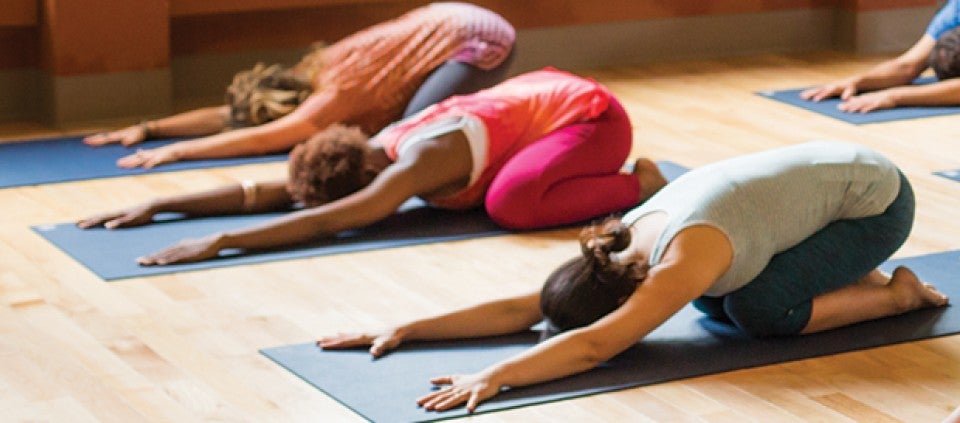Yoga for the Absolute Beginner

They say the first step is the hardest one. When you’re an absolute beginner peering into a yoga studio, it’s not unusual to be intimidated by the contortions some people’s bodies are capable of—but it’s a myth that you need to be as flexible as a rubber band to get on the mat.
On the contrary, you can start right where you are—weak triceps, tight hamstrings, and all. If you can refrain from comparing yourself to others, you’ll be surprised by the benefits you’re likely to reap from making a commitment to practicing on a regular basis, even if it’s just for a few minutes.
“Consistency yields higher results than occasional practice,” says Cristie Newhart, Dean of the Kripalu School of Yoga. Many people fail to practice regularly, Cristie explains, because they schedule more time for their practice than they actually have. “Just start with what feels comfortable,” she continues, “and you can grow it from there.”
If you’re especially self-conscious, a book or video offers a way to explore yoga at home and at your own pace, giving you a chance to get a taste of the ancient practice before trying out your Downward Dog in public. “Eventually, though,” Cristie says, “most people want class instruction to ensure they’re doing the postures safely and for the most benefit.”
If you’re embarking on a 30-minute yoga practice, for example, Cristie recommends breaking it down into four elements:
Yogic breathing (three minutes): Seated in a chair, lying on the floor, or sitting cross-legged, breathe in three distinct phases. First, inhale and fill your lower belly with air, to your maximum capacity. Then exhale, pulling the belly back gently to allow as much air as possible to escape from the lungs. Do this a few times. Then inhale again, filling your belly with air and allowing the breath to expand your rib cage as well. Exhale, squeezing all the air out of your rib cage until it’s empty. Then bring your breath all the way up into your collarbones … and slowly exhale. “Don’t try to force yourself to get the breath all the way into the sternum,” notes Cristie. “Straining doesn’t help; let it be organic.”
This practice is called Dirgha pranayama. Breathing in this manner at the beginning of yoga practice helps create mindfulness and focus. “It helps us let go of our active mind,” Cristie explains, “and sink into a quieter place, which is appropriate for practice.”
Movement (15 minutes): “Start slow with joint openers and give your body a chance to warm up,” suggests Cristie. “As best you can, move with the breath, letting it lead the way. Never force yourself to go beyond your limits.”
Cristie recommends striving for a balanced practice, which includes standing, seated, and balancing postures as well as postures on the belly and on the back. “We want to experience ourselves in different relationships to gravity,” she notes, “and we want to do postures that move the spine in its six directions—lateral (both sides), twist (both sides), forward bend, and backbend.”
While most people prefer doing postures they enjoy, Cristie urges beginners to mix it up with more challenging postures—just make sure there’s no sharp pain near or in a joint. “Discomfort in a muscle is okay, but pain is not,” she says.
Relaxation (seven minutes): After engaging your body, it’s time to let go into deep relaxation. Lie on your back or your side, support your knees by placing a cushion under them, and/or support your head with a folded blanket. You can also place an eye pillow or a cloth over your eyes. Make yourself as comfortable as possible so you can allow yourself to melt into the floor.
Some say Savasana (Corpse pose) is the hardest pose in yoga. “That’s because there’s nothing to do here,” Cristie notes. “It requires nothing from us.”
Meditation (five minutes): “A lot of people skip meditation because they don’t understand what it is,” Cristie says. “Meditation isn’t quieting the mind—a quiet mind is the result of meditation. It takes practice, but yields tons of benefits, such as focus, clarity, calmness, peace of mind, and so on. After practicing yoga, meditation is more accessible.”
Bring your attention to the point in your body where you feel your breath the most strongly. Expect your attention to fade and wander. When you become aware that your attention has wandered, simply return to watching your breath.
Cristie says that consistent yoga practice—whether for an hour or just 10 to 15 minutes a day—results in increased flexibility and strength, improved respiration, and more energy and vitality. “Each person is different,” she says, “but it usually doesn’t take long to notice that our bodies are changing, and our perspectives are, too.”
Find out about upcoming programs with Cristie Newhart at Kripalu.